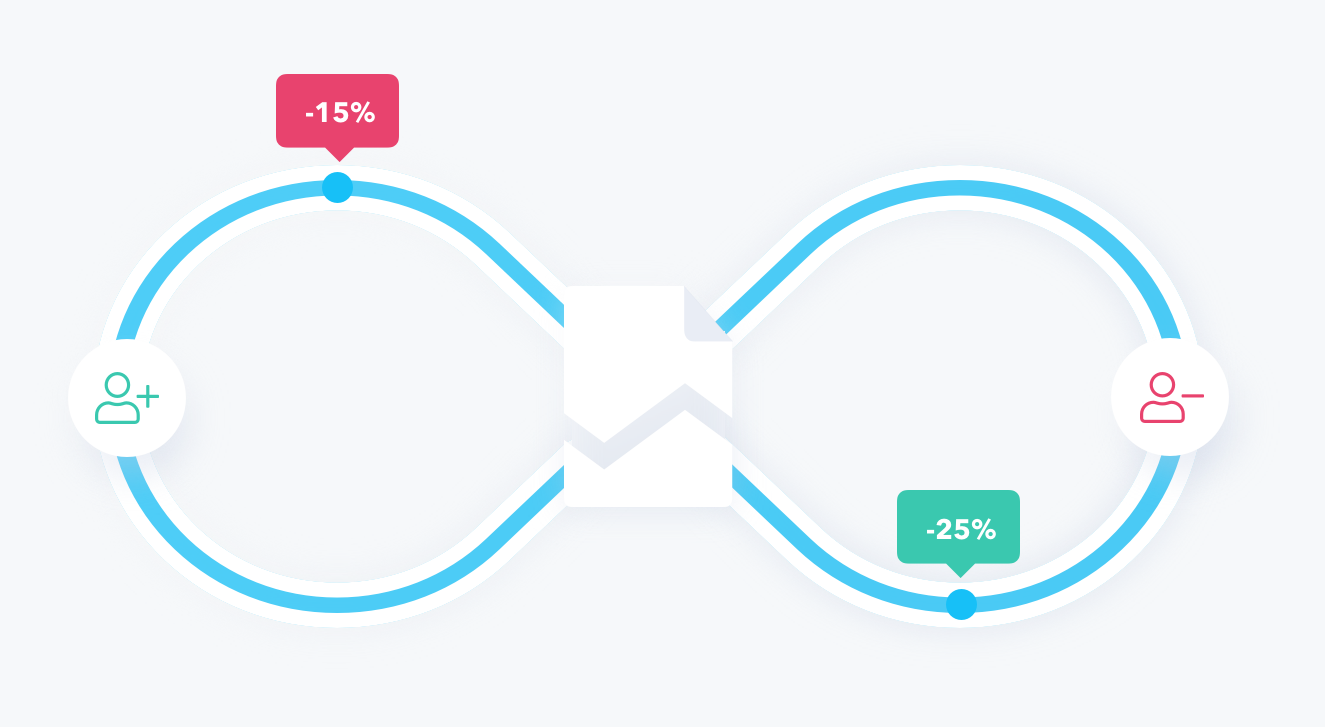We have all seen it.
You went through all the discovery calls, explained the value of your service to the finest detail, got the final buy-in from the prospect, and the inevitable question comes:
“What can we do about the price? I need a discount to push this through.”
But what to do in such a situation?
You obviously don’t want to lose time in lengthy negotiations or even lose a potential deal altogether just because of 10-20%.
There are different ways to react in this situation.
But first we should have a look at the “State of Discounts”.
This article is for anyone working in B2B sales, either as a leader or as a sales rep on the floor looking to improve his discounting model.

Discounts have become an expectation. But they shouldn’t.
Discounts have spread in our industry like a disease: customers expect you to lower the price as soon as a price discussions begins. They assume that you have already included an inevitable 10-15% discount in your initial price.
But you probably haven’t.
You probably sat down in long sessions and meetings to define a pricing model where both your customers and you are benefiting (I will write a blog post on pricing strategies soon, make sure to subscribe to the Accordium Blog). Your CFO (like me) probably made complicated calculations on what a fair price should be in order to be competitive in the market, drive value for your customers, while still having sustainable profit margins.
Discounts can make all that work worthless and can do real harm to your business if not done correctly.
Accordium’s Co-Founder Alexander Brix on how to manage discounts.
Competition is fierce and you are scared to ask for what you think is the right price
So why should you give a discount?
Maybe you are scared that your prospect is already talking to your competitor and you want to undercut him?
Competition is fierce in our digital age. It has become rare that a company has such unique products that it can reach monopoly and ask whatever price they want (let’s disregard GAFA for a second). That means, many companies decide to compete on price, instead of a superior product.
However, competing on price comes with a lot of risk.
What if somebody undercuts you even further because they are bigger, have more funding, or simply are able to maintain good profit margins due to the location of their company?
Well, then you will have nothing else to negotiate with and basically have to drop your pants and follow any price the market requests.
But there are more risks to it.
Customers talk to each other: Your discount strategy will become your standard pricing.
What if a customer gets pissed off because he finds out that another customer got a better deal than him?
Nowadays there are great platforms like G2Crowd or Capterra that create transparency in the market. Any person can not only check the value of your product, but also how much its worth to others.
Thus, your discount strategy will quickly become your standard pricing.
And then the bottom is the limit.
Creating a Discount Sales Culture is a Self-Fulfilling Prophecy.
Giving discounts might be ok in one-off cases (I explain below when that is), but don’t let them become the standard operating procedure.
If one sales rep is successfully hitting his targets every quarter simply because he has given discounts on every possible occasion, then other sales reps will definitely follow him.
The right incentivisation model for sales reps can ensure this doesn’t happen (I will cover the topic of sales incentivisation models in another blog post, make sure to subscribe). For a start, the sales amount in $ alone should never be the incentivized target. Make sure to include profitability metrics, such as Average Value per Deal (split by customer segments) and incentivize sales reps on its performance.
Creating a discount culture will break your unit economics and will be self-fulfilling prophecy.
The more discounts you give, the less successful your company will be and the less likely it is that you are able to build a superior product that can compete on value rather than price, and consequently will have to give even more discounts.
What is more, Sales reps will forget how to actually measure the value of your product and thus sell it. The result is in any case: you are only competing on pricing.
If you have to give discounts, do it right.
1) Re-evaluate your Value – How much is your product worth?
If you are 1000% sure about the value you deliver, why would you give a discount at all?
You didn’t decide on a price just out of gut feeling.
You made a proper business case, evaluating the benefits of your product and how that value should be distributed between you and the customer.
Make sure to re-evaluate those assumptions. If you do deliver a value and believe you have priced it correctly, then maybe you are not selling to the right customer.
Reconsider who realizes the most value of your product and ensure you are targeting those customers first: Regions, industries, company size, etc. all are factors that contribute to the factor of whether they derive the full value of your customer.
2) Ask your prospect why he thinks he should get a discount and what you get for it?
You should never just hand out discounts without a reason. Just wanting to hit your targets doesn’t count as a reason.
Ask your prospect what you can get in return. This can be a variety of things:
- Introduce you to other leads in his industry
- Let you write a guest blog post on their channels
- Create a customer case study showing the value of your product
- Take part in extensive beta testing or UX studies
- Use their logo on your website as a lighthouse customer
- Offer his own product/service at a discount to you as well (i.e. barter deal)
- etc.
There really are a lot of ways how you and your future customer can work together to create value.
Remember, if you give out things for free they don’t have a value. But if you ask for something in return, the perceived value you are bringing to the table will also increase. So don’t be afraid to ask for a favor.
3) Standardize discounting
One way of dealing with discounting (if you really have to do it), is by standardizing it.
There are multiple reasons why you would want to do that:
Better financial planning and stable unit economics
As a CFO at Accordium I can tell you, not being able to predict unit economics and profit margins keeps me awake at night (not really, our CCO is doing a great job). It is extremely important to being able to accurately calculate unit economics, as they will also determine how much you can spend on sales, marketing and other operations. If you end up having lower profit margins but spend the same amount of money on acquiring customers, your shareholders will definitely not be happy.
Decision Efficiency: Time kills all deals
Standardizing decision processes on discounts will also make you leaner and quicker. Of course, there’s always situations where you have to flexible, but in general standards help in decision making.
To give you an example: If a sales rep has to ask his manager for permission for every single discount he wants to give away, that will significantly delay the signing of the customer on a normal day – not even taking into account that people can be sick, on vacation, or just busy.
And remember, time kills all deals. Once you have the buy-in, you want to get the deal signed as quickly as possible before anything comes up.
By having a standard discount list the sales rep knows exactly what he can do and what he can’t. As long as you have your incentive model planned out correctly (see above), the sales rep will not go out and give everybody the max possible discount to achieve his revenue goal, but will be mindful of profits as well.
Customers talk to each other
I can’t stress this enough: The days where you can give different deals to different customers are over. Companies talk to each other and review your services online. Pricing strategies are public to everybody, no matter whether you like it or not. Therefore, if you don’t want to end up with unsatisfied customers who later realize they are paying too much, standardize your discounts.
There a different ways to standardize discounting. It depends a lot on your industry and your business model which one works best.
3.1 Tiered Pricing and Discounting
If your pricing is based on a quantifiable unit (e.g. number of users; number of units consumed; etc.), then a tiered pricing should be in place. This is not necessarily a discounting model, but it is still a way to reward customers for buying more. End of the day you most likely have some kind of economy of scale, i.e. you will still make more profit by selling more for a lower per unit price, then if you gave less discount and sold less. But remember, this has to be standardized (see above)
On top of that, you should standardize the discounting model for tiered pricing as well, i.e. a company that needs x-y units will get a discount between z-a, and so on.
3.2 Tit-for-Tat
As mentioned above, discounts can be given if you get something in return, like a customer case study that will require a few hours of your customer’s time. Make sure to put a standardized value on such agreements (remember, customers talk to each other and you don’t want to piss them off).
3.3 Regions
Different regions might come with different competitors and thus different pricing and product competition. Unless you already have a localized pricing model, you might want to use a standardized discounting model for each market to adapt to local expectations. Some countries also simply have a culture of negotiating, where it’s just a matter of politeness and maybe also enjoyment to discuss prices back and forth. In this case it actually does make sense to include an expected discount in your initial quote.
4) Draw a line and do not be afraid to walk away
Sometimes, there’s just no other way than walking away from the table. You will have situations where prospects fiercely negotiate about every small detail and discount percentage.
In many cases, this is just tactics and the prospect will come back and buy anyway. Don’t forget that they also have to report to somebody and need to get it done and already spend time finding the right solution. This is a two way street, not just you desperately trying to get customers.
Let’s face it. These are probably not the type of people you want to work with anyway.
Secondly, they are probably not even your ideal customer because they don’t seem to see the same value in your product as others. So take a step back and reevaluate who you should be selling to.
End of the day, discounts can’t be fully avoided, and that is fine. But there are right ways to do it without harming your business.
How do you handle discounts on the sales floor?
I would love to hear your experience – shoot me an email!



